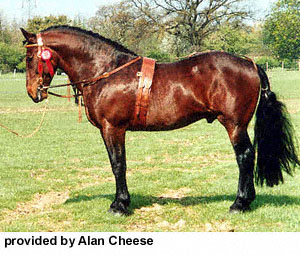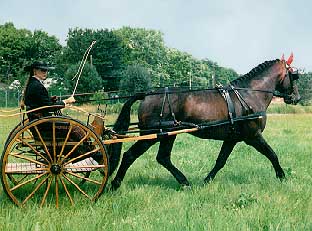

Cleveland Bay


Introduction: If you have any comments or suggestions, please click here.
Names: Cleveland Bay. "Cleveland" for the district in England that it is from; "Bay" because it is always that color.
Origin: England, Yorkshire. All horses entered in the Cleveland Bay Stud Book are registered as Cleveland Bays. Descended from the Chapman horse, the Cleveland Bay is an old English breed with a high proportion of Thoroughbred blood, originally much heavier than it is today. Widespread pure breeding since foundation of Cleveland Bay Horse Society last century (probably meaning the 1800s).
Breeding: Before the roads were fit for wagons, merchandise was carried in panniers on either side of pack-horses, known in the Cleveland district of Yorkshire as "Chapmans Horses." These sturdy, short-legged creatures were the part ancestors of the Cleveland Bay and were in great demand for drawing the coaches that first became popular during the reign of Elizabeth I. In the 18th century, the old Cleveland Bays were improved by two Thoroughbred sires. Later, more Thoroughbred crossings with some Cleveland mares produced the fine, showy Yorkshire Coach Horses of pre-motoring days.
Description: General impression is of a rather long legged and thin horse.
Action: Striding action in walk; level, progressive, energetic trot. Excellent galloping and jumping ability.
Body: Neck strong but not too short. Good sloping shoulders. Fairly long, flattish barrel. Long quarters.
Color: Always bay, without white markings. Light to chestnut bay with black mane and tail.
Head: Quite large, not very noble, yet well carried.
Legs: Usually ample length of cannon. Knees often flat and unimpressive. Hocks broad and well-shaped.
Size: 15-16.2 hands. 15.3 to 16 hands.
Temperament:
Features: Sure footed, but not very fast. Quality horses possessing much courage and stamina. Medium weight, strong, all-purpose and easily trained half-bred horse.
Uses: Owning no
cart-horse blood, Cleveland Bays are the only pure breed of general utility
horse, equally good for farm work, in harness, or under saddle. Crossed
with quality mares, the stallions sire first-class heavyweight hunters. Used
for carriage work. Good jumper. Crossing the Cleveland Bay with the Thoroughbred
produces a useful half-bred hunter.
Closely linked to the British royal family, the Cleveland Bay
is often used today to pull royal carriages on important state occasions.
Queen Elizabeth II has started a breeding program for these horses because they
are under threat of becoming extinct.
Accomplishments:
Curiosities:
Profiles:
Conclusion: